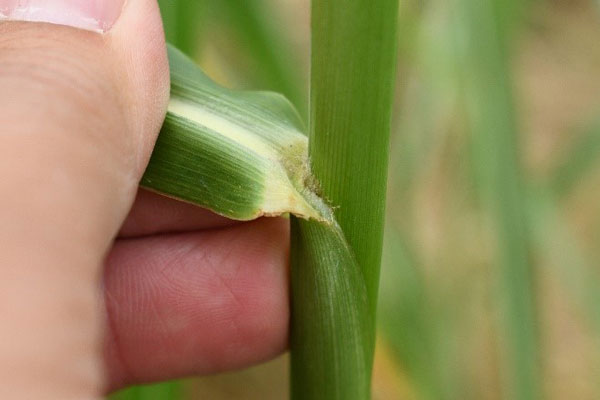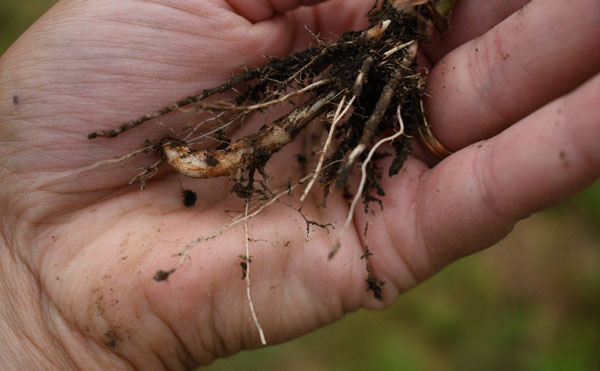Questions about johnsongrass (Sorghum halepense) control are starting to come in, making it a good species to feature in the July World of Weeds article.
Ecology of johnsongrass
Johnsongrass is a warm-season, perennial plant native to the Mediterranean region. It was introduced in the southern states as a forage crop during the early 1800s. Johnsongrass can be found throughout the United States. It is a noxious weed in Kansas, as well as neighboring states Colorado and Missouri. Johnsongrass grows in fields, pastures, rights of way, and many other sites. It does produce substantial forage, but can accumulate prussic acid and nitrates that are harmful to livestock. In addition, johnsongrass can be a source of insects and diseases that affect corn and sorghum crops.
Identification
Johnsongrass leaves are generally 7 to 24 inches long and 0.25 to 1.25 inches wide with a prominent white midrib. They are usually hairless, but some plants do have a few hairs at the base of the leaf. The ligule is relatively large, about 0.1 to 0.2 inches tall. It is a membrane topped with a fringe of hairs (Figure 1). Leaf sheaths have no hairs and do not touch. Stems grow upright and can reach heights over 10 feet.

Figure 1. Johnsongrass ligule. Photo by Sarah Lancaster, K-State Research and Extension.
Johnsongrass seed heads are open panicles (Figure 2) that emerge throughout the summer. Panicles are 5 to 20 inches long with many branches that are arranged in whorls. Seeds are reddish-brown, about 0.1 to 0.25 inches long and football-shaped. In addition to seeds, johnsongrass can spread by rhizomes (Figure 3). Johnsongrass growing from rhizomes will typically emerge earlier in the spring than seedling johnsongrass.

Figure 2. Johnsongrass panicle. Photo by Sarah Lancaster, K-State Research and Extension.

Figure 3. Johnsongrass rhizome. Photo by Sarah Lancaster, K-State Research and Extension.
Johnsongrass, especially seedling johnsongrass, can be confused with shattercane (Sorghum bicolor). Carefully digging the plant to look at attached seeds is helpful for telling the two apart. Shattercane seeds are generally more round in shape and less red in color than johnsongrass. Mature plants can be distinguished by the more either looking for rhizomes, which are absent in shattercane, or based on differences in the seeds/seed head.
Management
Johnsongrass can cause significant yield loss in row crops if not controlled. Glyphosate is effective on seedling and rhizome johnsongrass and can be used in glyphosate-resistant corn hybrids and soybean varieties. Group 1 herbicides, such as clethodim (Select Max, others), fluazifop (Fusilade DX), quizalofop (Assure II, others), or sethoxydim (Poast Plus) can also be used in soybeans. Johnsongrass management in grain sorghum is more difficult. Rotation to a crop where effective herbicides can be used is generally the best practice to manage johnsongrass in grain sorghum. Products used in some herbicide-resistant grain sorghum hybrids are effective on johnsongrass; however, product stewardship concerns prevent their use in fields where johnsongrass is prominent.
In pastures, spot sprays of glyphosate can help manage johnsongrass. Imazapic (Plateau, others) may be used to manage johnsongrass in some native and introduced grasses; however, desirable grass species have varying degrees of sensitive to imazapic, so it is important to carefully read the product label to find the appropriate rate for your situation.
Resistance to glyphosate, as well as Group 1 and Group 2 (ALS-inhibiting) herbicides has been confirmed in johnsongrass in many southern states, as well as Indiana. Additional johnsongrass populations resistant to nicosulfuron (Accent, Zest, others) have been reported in Kansas and Nebraska.
References
Werle et al., 2016
The use of trade names is for clarity to readers and does not imply endorsement of a particular product, nor does exclusion imply non-approval. Always consult the herbicide label for the most current use requirements. For more information, see 2021 Chemical Weed Control for Field Crops, Pastures, Rangeland, and Noncropland, K-State publication SRP-1162.
Sarah Lancaster, Extension Weed Management Specialist
slancaster@ksu.edu
Tags: World of Weeds johnsongrass